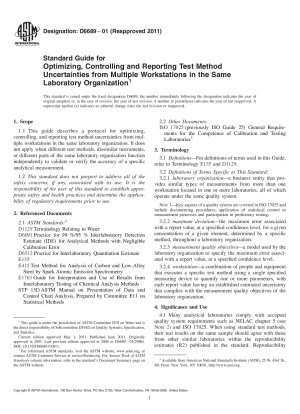ASTM D6689-01(2011)
Standard Guide for Optimizing, Controlling and Reporting Test Method Uncertainties from Multiple Workstations in the Same Laboratory Organization
- Standard No.
- ASTM D6689-01(2011)
- Release Date
- 2001
- Published By
- American Society for Testing and Materials (ASTM)
- Status
- Replace By
- ASTM D6689-01(2019)e1
- Latest
- ASTM D6689-01(2019)e1
- Scope
Many analytical laboratories comply with accepted quality system requirements such as NELAC chapter 5 (see Note 2) and ISO 17025. When using standard test methods, their test results on the same sample should agree with those from other similar laboratories within the reproducibility estimates (R2) published in the standard. Reproducibility estimates are generated during the standardization process as part of the interlaboratory studies (ILS). Many laboratories participate in proficiency tests to confirm that they perform consistently over time. In both ILS and proficiency testing protocols, it is generally assumed that only one workstation is used to generate the data (see 6.5.1).
Note 28212;NELAC chapter 5 allows the use of a Work Cell where multiple instruments/operators are treated as one unit: the performance of the Work Cell is tracked rather than each workstation independently. This guide is intended to go beyond the Work Cell to achieve the benefits of monitoring workstations independently.
Many laboratories have workloads and/or logistical requirements that dictate the use of multiple workstations. Some have multiple stations in the same area (central laboratory format). Others'' stations are scattered throughout a facility (at-line laboratory format). Often, analysis reports do not identify the workstation used for the testing, even if workstations differ in their testing uncertainties. Problems can arise if clients mistakenly attribute variation in report values to process rather then workstation variability. These problems can be minimized if the laboratory organization sets, complies with, and reports a unified set of measurement quality objectives throughout.
This guide can be used to harmonize calibration and control protocols for all workstations, thereby providing the same level of measurement traceability and control. It streamlines documentation and training requirements, thereby facilitating flexibility in personnel assignments. Finally, it offers an opportunity to claim traceability of proficiency test measurements to all included workstations, regardless on which workstation the proficiency test sample was tested. The potential benefits of utilizing this protocol increase with the number of workstations included in the laboratory organization.
This guide can be used to identify and quantify benefits derived from corrective actions relating to under-performing workstations. It also provides means to track improved performance after improvements have been made.
It is a prerequisite that all users of this guide comply with ISO 17025, especially including the use of documented procedures, the application of statistical control of measurement processes, and participation in proficiency testing.
The general principles of this protocol can be adapted to other types of measurements, such as mechanical testing and on-line process control measurements such as temperature and thickness gauging. In these areas, users will likely need to establish their own models for defining measurement quality objectives. Proficiency testing may not be available or applicable.
It is especially important that users of this guide take responsibility for ensuring the accuracy of the measurements made by the workstations to be operated under this protocol. In addition to the checks mentioned in 6.2.3, laboratories are encouraged to use other techniques, including, but not limited to, analyzing some materials by independent methods, either within the same laboratory or in collaboration with other equally competent laboratories. The risks associated with generating large volumes of data from carefully harmonized, but incorrectly calibrated multiple workstations are obvious and must be avoided.
1.1 This guide describes a protocol for optimizing, controlling, and reporting test method uncertainties from......
ASTM D6689-01(2011) Referenced Document
- ASTM D1129 Standard Terminology Relating to Water
- ASTM D6091 Standard Practice for 99 %/95 % Interlaboratory Detection Estimate (IDE) for Analytical Methods with Negligible Calibration Error
- ASTM D6512 Standard Practice for Interlaboratory Quantitation Estimate*, 2024-04-19 Update
- ASTM E1763 Standard Guide for Interpretation and Use of Results from Interlaboratory Testing of Chemical Analysis Methods
- ASTM E415 Standard Test Method for Optical Emission Vacuum Spectrometric Analysis of Carbon and Low-Alloy Steel
- ISO/IEC 17025 General requirements for the competence of testing and calibration laboratories [Standard in French]
ASTM D6689-01(2011) history
- 2019 ASTM D6689-01(2019)e1 Standard Guide for Optimizing, Controlling, and Reporting Test Method Uncertainties from Multiple Workstations in the Same Laboratory Organization
- 2001 ASTM D6689-01(2011) Standard Guide for Optimizing, Controlling and Reporting Test Method Uncertainties from Multiple Workstations in the Same Laboratory Organization
- 2001 ASTM D6689-01(2006) Standard Guide for Optimizing, Controlling and Reporting Test Method Uncertainties from Multiple Workstations in the Same Laboratory Organization
- 2001 ASTM D6689-01 Standard Guide for Optimizing, Controlling and Reporting Test Method Uncertainties from Multiple Workstations in the Same Laboratory Organization
